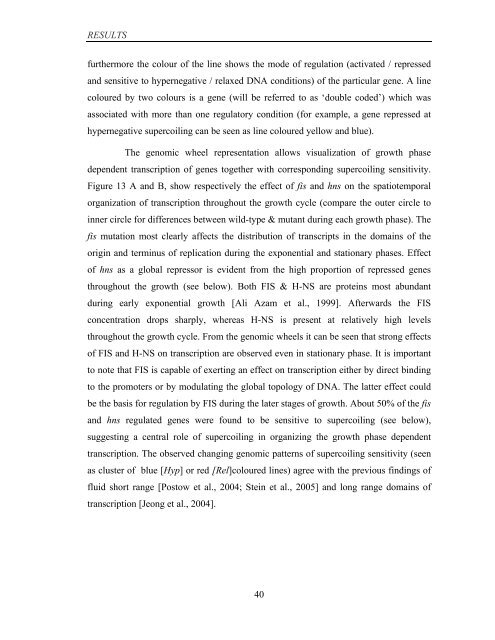Coordinated regulation of gene expression by E ... - Jacobs University
Coordinated regulation of gene expression by E ... - Jacobs University
Coordinated regulation of gene expression by E ... - Jacobs University
Create successful ePaper yourself
Turn your PDF publications into a flip-book with our unique Google optimized e-Paper software.
RESULTS<br />
furthermore the colour <strong>of</strong> the line shows the mode <strong>of</strong> <strong>regulation</strong> (activated / repressed<br />
and sensitive to hypernegative / relaxed DNA conditions) <strong>of</strong> the particular <strong>gene</strong>. A line<br />
coloured <strong>by</strong> two colours is a <strong>gene</strong> (will be referred to as ‘double coded’) which was<br />
associated with more than one regulatory condition (for example, a <strong>gene</strong> repressed at<br />
hypernegative supercoiling can be seen as line coloured yellow and blue).<br />
The genomic wheel representation allows visualization <strong>of</strong> growth phase<br />
dependent transcription <strong>of</strong> <strong>gene</strong>s together with corresponding supercoiling sensitivity.<br />
Figure 13 A and B, show respectively the effect <strong>of</strong> fis and hns on the spatiotemporal<br />
organization <strong>of</strong> transcription throughout the growth cycle (compare the outer circle to<br />
inner circle for differences between wild-type & mutant during each growth phase). The<br />
fis mutation most clearly affects the distribution <strong>of</strong> transcripts in the domains <strong>of</strong> the<br />
origin and terminus <strong>of</strong> replication during the exponential and stationary phases. Effect<br />
<strong>of</strong> hns as a global repressor is evident from the high proportion <strong>of</strong> repressed <strong>gene</strong>s<br />
throughout the growth (see below). Both FIS & H-NS are proteins most abundant<br />
during early exponential growth [Ali Azam et al., 1999]. Afterwards the FIS<br />
concentration drops sharply, whereas H-NS is present at relatively high levels<br />
throughout the growth cycle. From the genomic wheels it can be seen that strong effects<br />
<strong>of</strong> FIS and H-NS on transcription are observed even in stationary phase. It is important<br />
to note that FIS is capable <strong>of</strong> exerting an effect on transcription either <strong>by</strong> direct binding<br />
to the promoters or <strong>by</strong> modulating the global topology <strong>of</strong> DNA. The latter effect could<br />
be the basis for <strong>regulation</strong> <strong>by</strong> FIS during the later stages <strong>of</strong> growth. About 50% <strong>of</strong> the fis<br />
and hns regulated <strong>gene</strong>s were found to be sensitive to supercoiling (see below),<br />
suggesting a central role <strong>of</strong> supercoiling in organizing the growth phase dependent<br />
transcription. The observed changing genomic patterns <strong>of</strong> supercoiling sensitivity (seen<br />
as cluster <strong>of</strong> blue [Hyp] or red [Rel]coloured lines) agree with the previous findings <strong>of</strong><br />
fluid short range [Postow et al., 2004; Stein et al., 2005] and long range domains <strong>of</strong><br />
transcription [Jeong et al., 2004].<br />
40
















